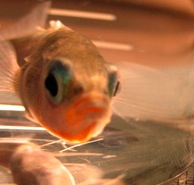 To foster the best possible undergraduate research experience, biology has created a systematic approach to placing students in the right labs.
To foster the best possible undergraduate research experience, biology has created a systematic approach to placing students in the right labs.
There are more than thirty faculty members in the UO biology department, working on the cutting edge in cell biology, developmental biology, genetics, biochemistry, ecology and evolution, neuroscience and behavior, and more.
The department regularly distinguishes itself for advanced programs in molecular evolution and genomics, and it is the home of the zebrafish, an animal model for studies of human health and disease developed at the UO and now used in laboratories throughout the world. Interdisciplinary efforts are the rule, as prominent scientists push themselves to see things through a new lens of discovery.
For the ambitious undergraduate, the question can be daunting: How do I find a mentor among these high-powered scientists?
“I’m not sure students even realize the amount of research opportunities that are available,” said Matthew Davis, who graduated recently with a biology degree. “It can feel pretty alienating just sending out e-mails and hoping to catch a professor’s eye.”
Davis eventually found a good position in a laboratory, but it was a trial-and-error process with more than one false start. Now the biology department is making it easier for talented undergraduates to find the right laboratory—and professor—for them.
The SMART-Biology program— Scientific Mentorship and Research Training in Biology—is being launched to match undergraduate students with research faculty members. Sophomores and juniors who meet academic requirements can submit an application and a coordinator will broadcast their interests throughout the department, seeking to match applicants with faculty members for interviews.
Among the 900 biology majors at the UO, more than seventy are working in laboratories. But pairing students with laboratories has historically been a convoluted, time-consuming process that detracts from the research experience, said Kryn Stankunas, an assistant professor who helped establish the program.
“There are exciting, transformative opportunities here—if you want to do research in a lab, you’re not just going to be performing menial tasks,” he said. “Students have to become immersed in experiments to learn from the experience. The SMART-Biology program is intended to show students what expectations there would be and what they can expect to achieve from laboratory research.”
Besides establishing a mentoring relationship with a professor, SMART participants will have research meetings with peers and graduate students, and will present their work at an annual symposium. The program, which includes an honors thesis track, serves students who are pursuing graduate schools and research careers—or simply desire an authentic, hands-on experience working in a laboratory.
Davis originally tried the mass e-mail approach for finding a position, only to discover that most faculty members and graduate students are exceptionally busy and it was difficult to establish a working rapport with them. He eventually landed a spot in a laboratory—only to discover that it wasn’t a good fit for his interests.
Things changed in spring 2011, when a freshwater ecology class opened Davis’s eyes to the fungal world existing in the soil. Intrigued, he starting making inroads in research, earning a scholarship and a grant for his work.
He traveled to Ecuador, where he assisted graduate students and professors who were studying the mating strategy of orchids. And he landed a satisfying position in the laboratory of associate professor Barbara “Bitty” Roy, who studies the effects of fungi and insects on the ecology and evolution of plants. Eventually, he completed a thesis on an invasive grass in western Oregon that has spread aggressively in the absence of a fungus that is a “specialist enemy.”
For Davis, it all started clicking once he had been “appropriately matched” with a laboratory—which is precisely the goal of the SMART program.
“Research was the fusion that made me feel like a part of this place,” Davis said. “It’s all about establishing a relationship with a professor.”
—Matt Cooper


-thumb-200x200-1722-thumb-100x100-1723.jpg)


 From federal forest payments to the benefits of reading readiness, econ honors projects get real.
From federal forest payments to the benefits of reading readiness, econ honors projects get real. SPUR student receives prestigious Howard Hughes Medical Institute Award.
SPUR student receives prestigious Howard Hughes Medical Institute Award.